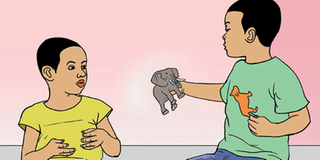How to raise a caring child (age 5)

What you need to know:
Label the feeling. Your kindergartner will be able to understand and manage her emotions much better if she can recognise her feelings. So put a name to her behaviour as often as you can. Say, for instance, “It was very kind of you to talk to that boy who was all alone on the swing. He might have been feeling lonely.” By hearing that you noticed her behaviour, she’ll learn that you recognise and value her responsiveness.
Children don’t have the cognitive skills to truly understand the concept of empathy until they’re 8 or 9. But 5-year-olds, usually highly preoccupied with fairness, are concerned about being treated well, and they want others – friends, strangers, even characters in books – to be treated well too. Here’s how to nurture these budding displays of empathy.
Label the feeling. Your kindergartner will be able to understand and manage her emotions much better if she can recognise her feelings. So put a name to her behaviour as often as you can. Say, for instance, “It was very kind of you to talk to that boy who was all alone on the swing. He might have been feeling lonely.” By hearing that you noticed her behaviour, she’ll learn that you recognise and value her responsiveness.
She needs to understand negative emotions, too, so don’t be afraid to calmly point out when your 5-year-old’s being less than caring. Try saying, “It made your baby brother really sad when you grabbed his rattle. What could you do to help him feel better?”
Another way to teach your kindergartner to understand and define her emotions is to have a “feeling of the week.” Each week, put up on the refrigerator or bulletin board a picture of someone experiencing a basic emotion – sadness, happiness, surprise, anger. Work your way up to more complicated emotions, such as frustration, nervousness, and jealousy. Talk with your child about times when she felt the same way.
Praise empathetic behaviour When your kindergartner performs an act of kindness, tell her what she did right, and be as specific as possible: “You were very generous to share your special stickers with Tommy. I saw him smiling, and I know he was happy.”
Encourage your kindergartner to talk about her feelings – and yours.Let her know that you care about how she feels by listening intently. If she has a story about someone else (“Tommy got in trouble for shoving Therese, and I don’t think that was fair”), listen to her views before offering your own. And when she says she’s mad, paraphrase what she says – “Oh, you’re feeling grumpy today?” – so she knows you’re listening and feels encouraged to elaborate.
Similarly, share your own feelings with her: “It makes me feel bad when you yell at me. Let’s think of another way for you to tell me you’re angry.” This is also a fine time to share some of your feelings that don’t relate to your child’s actions. You can say, “I’m frustrated that I didn’t meet my deadline at work today” or “I got annoyed with Aunt Mary today, just like you get mad at your sister. But we’re still friends.”
Your 5-year-old will learn that adults have feelings and emotions too, that they’re a normal part of life, and that learning to cope with them is an important part of growing up.
Point out other people’s behaviour
Teach your kindergartner to notice when someone else has behaved kindly. You might say, for example, “Remember how friendly your new teacher was on the first day of school? She helped you feel less scared.” By doing this, you reinforce her understanding of how people’s actions can affect her emotionally.
Books also provide wonderful opportunities to explore emotions. Ask your 5-year-old how she thinks the children in a fairy tale are feeling, and whether she thinks she’d be scared or brave in the same situation. Tell her how you might feel too.
Teach nonverbal cues. At the playground or park, find a quiet place where you and your 5-year-old can sit and observe others without being rude. Play a game of guessing what other people are feeling, and explain the specific reasons for your own guesses: “See that man? He’s walking really quickly and his shoulders are hunched, and he’s making a mean face. I think he’s angry about something.”
Teach basic rules of politeness
Good manners are a great way for your kindergartner to show caring and respect for others. “Please” and “thank you” are phrases 5-year-olds should use automatically. Explain that you’re more inclined to hand over her sandwich when she asks for it politely and that you don’t like it when she orders you around. Even if these phrases sound rote at times, they teach kids how important it is to treat others with respect. Of course, being polite to her is worth a thousand rules and explanations. Say “please” and “thank you” regularly to your kindergartner and to others, and she’ll learn that these phrases are part of normal communication, both at home and out in public.




